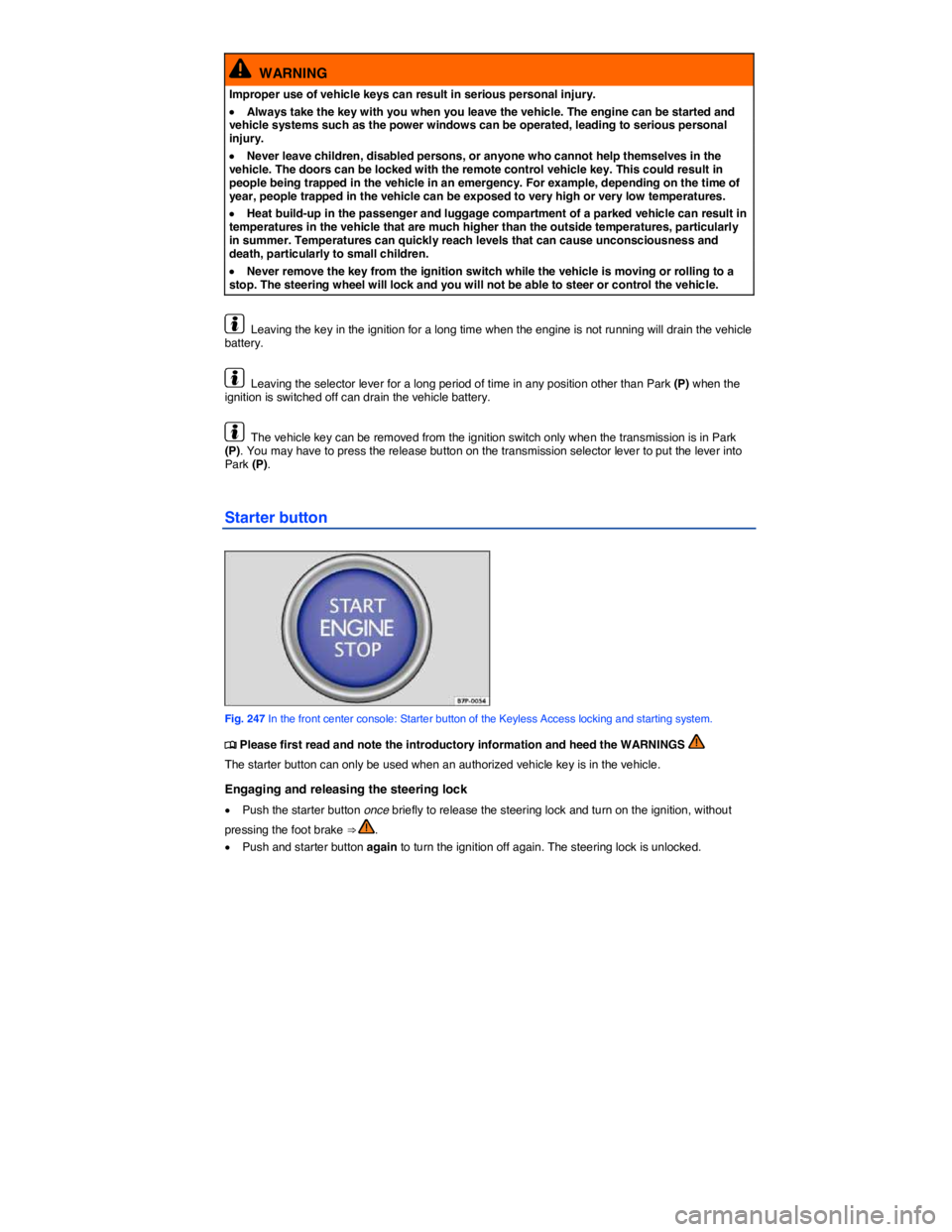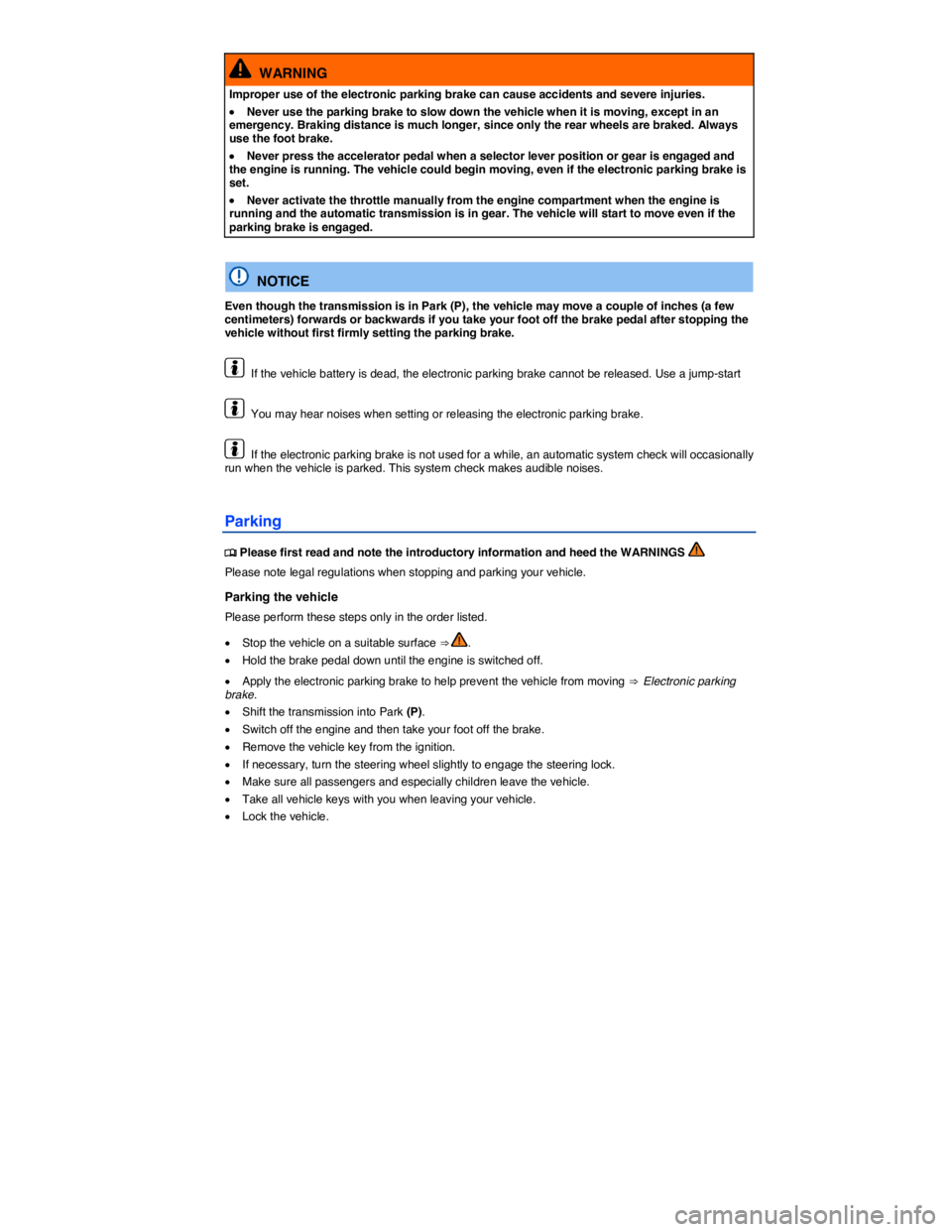2012 VOLKSWAGEN TOUAREG battery
[x] Cancel search: batteryPage 197 of 684

Load rating (code)
The maximum load that a tire is rated to carry for a given inflation pressure. You may not find this information on all tires because it is not required by law.
Maximum load rating
The load rating for a tire at the maximum permissible inflation pressure for that tire.
Maximum loaded vehicle weight
The total of:
�x Curb weight
�x Accessory weight
�x Vehicle capacity weight
�x Production options weight
Maximum (permissible) inflation pressure
The maximum cold inflation pressure to which a tire may be inflated. Also called “maximum inflation pressure.”
Normal occupant weight
Means 150 lbs (68 kilograms) times the number of occupants seated in the vehicle up to the total seating capacity of your vehicle.
Occupant distribution
The placement of passengers in a vehicle.
Outer diameter
The diameter of a new, properly inflated tire.
Overall width
Total width measured at the exterior sidewalls of an inflated tire, including the additional width of labeling, decorations, or protective bands or ribs.
Passenger car tire
A tire intended for use on passenger cars, multipurpose passenger vehicles, and trucks, that have a gross vehicle weight rating (GVWR) of 10,000 pounds or less.
Ply
A layer of rubber-coated parallel cords.
Ply separation
A parting of rubber compound between adjacent plies.
Pneumatic tire
A mechanical device made of rubber, chemicals, fabric, and steel or other materials, that, when mounted on an automotive wheel, provides the traction and contains the gas or fluid that sustains the load.
Production options weight
The combined weight of installed regular production options weighing over 5 lbs (2.3 kg) more than the standard items they replace, and not previously considered as curb weight or accessory weight. These include, for example, heavy-duty brakes, ride levelers, roof rack, heavy-duty battery, and special trim.
Page 210 of 684

Key to ⇒ fig. 116
Position number Meaning
(5) No data received, right rear tire.
(6) Benchmark pressure, rear tires.
If the tire pressure is too low, the relevant tires and the respective readings are shown in yellow
⇒ fig. 116.
Each tire, including the spare (if provided), should be checked monthly when cold and inflated to the inflation pressure recommended by the vehicle manufacturer on the vehicle placard or tire inflation pressure label. (If your vehicle has tires of a different size than the size indicated on the vehicle plac-ard or tire inflation pressure label, you should determine the proper tire inflation pressure for those tires.)
As an added safety feature, your vehicle has been equipped with a Tire Pressure Monitoring System (TPMS) that illuminates a low tire pressure telltale when one or more of your tires is significantly underinflated. Accordingly, when the low tire pressure telltale illuminates, you should stop and check your tires as soon as possible, and inflate them to the proper pressure. Driving on a significantly underinflated tire causes the tire to overheat and can lead to tire failure. Underinflation also reduces fuel efficiency and tire tread life, and may affect the vehicle's handling and stopping ability.
Please note that the TPMS is not a substitute for proper tire maintenance, and it is the driver's respon-sibility to maintain correct tire pressure, even if underinflation has not reached the level to trigger illumination of the TPMS low tire pressure telltale.
Your vehicle has also been equipped with a TPMS malfunction indicator to indicate when the system is not operating properly. The TPMS malfunction indicator is combined with the low tire pressure telltale. When the system detects a malfunction, the telltale will flash for approximately 1 minute and then remain continuously illuminated. This sequence will continue upon subsequent vehicle start-ups as long as the malfunction exists.
When the malfunction indicator is illuminated, the system may not be able to detect or signal low tire pressure as intended. TPMS malfunctions may occur for a variety of reasons, including the installation of replacement or alternate tires or wheels on the vehicle that prevent the TPMS from functioning properly. Always check the TPMS malfunction telltale after replacing one or more tires or wheels on your vehicle to ensure that the replacement or alternate tires and wheels allow the TPMS to continue to function properly.
Collapsible spare tire
The collapsible spare tire has no tire pressure sensor. When the collapsible spare tire is mounted on the vehicle, the Tire Pressure Monitoring System (TPMS) indicator light will flash in the instrument cluster display. The TPMS continues to monitor the other 3 wheels.
Tire storage
If the tires do not move for an extended period of time, the sensors will not transmit tire pressures to the system. This saves sensor battery life. When the ignition is switched on, the sensors transmit signals to the Tire Pressure Monitoring System (TPMS).
Page 370 of 684

The telephone control can be used as soon as the PHONE main menu is displayed on the Infotain-ment System screen.
When connecting automatically, the system will first search for the telephone that was last used in order to reconnect it with the telephone control. If this mobile phone is not in the Bluetooth range, the system will start to search for the mobile phone (user) that was used before it.
�x Switch on the ignition.
�x Enter the PIN code if it is not stored in the telephone control28.
Requirements for automatic connection
�d The mobile phone needs to have already been paired with the telephone control.
�d The mobile phone must be switched on and contain a valid SIM card to make telephone calls.
�d Bluetooth must be activated on the mobile phone.
�d The mobile phone should have no connection to another Bluetooth device.
�d The mobile phone must be within the Bluetooth range of the telephone control.
�d The ignition must be switched on.
�d The mobile phone must have been last connected to the telephone control or another mobile phone connected via Bluetooth is no longer in the Bluetooth range of the telephone control or its Bluetooth feature has been switched off.
If the automatic connection is made during an active telephone call, the telephone control can only make a connection via HFP. Change the Bluetooth connection to rSAP in order to use all tele-phone control functions.
If a Bluetooth connection cannot be set up even though all requirements are fulfilled or if the telephone control does not function “normally”, the mobile phone's system may have crashed. Re-move the battery and insert again. Switch the mobile phone back on and try to establish a Bluetooth connection.
Volkswagen recommends not switching on authorization on the mobile phone so that you confirm the connection queries again before each automatic connection setup.
28 country specific
Page 394 of 684

WARNING
Improper use of vehicle keys can result in serious personal injury.
�x Always take the key with you when you leave the vehicle. The engine can be started and vehicle systems such as the power windows can be operated, leading to serious personal injury.
�x Never leave children, disabled persons, or anyone who cannot help themselves in the vehicle. The doors can be locked with the remote control vehicle key. This could result in people being trapped in the vehicle in an emergency. For example, depending on the time of year, people trapped in the vehicle can be exposed to very high or very low temperatures.
�x Heat build-up in the passenger and luggage compartment of a parked vehicle can result in temperatures in the vehicle that are much higher than the outside temperatures, particularly in summer. Temperatures can quickly reach levels that can cause unconsciousness and death, particularly to small children.
�x Never remove the key from the ignition switch while the vehicle is moving or rolling to a stop. The steering wheel will lock and you will not be able to steer or control the vehicle.
Leaving the key in the ignition for a long time when the engine is not running will drain the vehicle battery.
Leaving the selector lever for a long period of time in any position other than Park (P) when the ignition is switched off can drain the vehicle battery.
The vehicle key can be removed from the ignition switch only when the transmission is in Park (P). You may have to press the release button on the transmission selector lever to put the lever into Park (P).
Starter button
Fig. 247 In the front center console: Starter button of the Keyless Access locking and starting system.
�
Page 397 of 684

�x Avoid high engine speeds, full throttle acceleration and heavy engine loads when the en-gine is cold.
�x Do not try to start the engine by pushing or towing the vehicle. Unburned fuel can get into the catalytic converter and damage it. The steering column may also be locked.
Do not let your vehicle warm up while standing; instead, start driving right away after making sure that you have good visibility through all windows. This will help the engine reach operating tempera-ture faster and keep down emissions.
If the battery in the remote control vehicle key is weak or dead, the engine cannot be started with the starter button. In this case, remove the starter button from the ignition switch and insert the remote control vehicle key into the ignition switch to start the vehicle.
Major consumers of electricity are temporarily switched off when the engine is being started.
After starting a cold engine, there may be increased operating noises for a few seconds. This is normal and harmless.
Stopping the engine
�
Page 406 of 684

WARNING
Moving the selector lever to the wrong position can cause loss of vehicle control, a collision, and serious personal injury.
�x Never accelerate when moving the selector lever.
�x When the engine is running and a drive position is engaged, the vehicle will start to move as soon as the brake pedal is released.
�x Never shift into Reverse or Park when the vehicle is moving.
WARNING
Unintended vehicle movement can cause serious personal injury.
�x Never get out of the driver's seat while the engine is running, especially when the trans-mission is in a drive gear. If you must leave your vehicle while the engine is running, always set the electronic parking brake and shift the transmission into Park (P).
�x Never leave the vehicle in Neutral (N). It will roll down hills, whether the engine is running or not.
�x When the engine is running and a drive gear - Drive (D), Sport Drive (S), or Reverse (R) - has been selected, press and hold the brake pedal to keep the vehicle from moving. The ve-hicle may “creep” and move forward or backward even if the engine is idling slowly.
�x Never shift into Reverse (R) or Park (P) when the vehicle is moving.
NOTICE
Even though the transmission is in Park (P), the vehicle may move a couple of inches (a few centimeters) forwards or backwards if you take your foot off the brake pedal after stopping the vehicle without first setting the electronic parking brake.
If the selector lever is moved into Neutral (N) by mistake when the vehicle is moving, take your foot off the accelerator pedal. Wait until the engine speed has dropped to idle speed before moving the selector lever into a drive gear.
Leaving the selector lever for a long period of time in any position other than Park (P) when the ignition is switched off can drain the vehicle battery.
Page 416 of 684

WARNING
Improper use of the electronic parking brake can cause accidents and severe injuries.
�x Never use the parking brake to slow down the vehicle when it is moving, except in an emergency. Braking distance is much longer, since only the rear wheels are braked. Alwa ys use the foot brake.
�x Never press the accelerator pedal when a selector lever position or gear is engaged and the engine is running. The vehicle could begin moving, even if the electronic parking brake is set.
�x Never activate the throttle manually from the engine compartment when the engine is running and the automatic transmission is in gear. The vehicle will start to move even if the parking brake is engaged.
NOTICE
Even though the transmission is in Park (P), the vehicle may move a couple of inches (a few centimeters) forwards or backwards if you take your foot off the brake pedal after stopping the vehicle without first firmly setting the parking brake.
If the vehicle battery is dead, the electronic parking brake cannot be released. Use a jump-start
You may hear noises when setting or releasing the electronic parking brake.
If the electronic parking brake is not used for a while, an automatic system check will occasionally run when the vehicle is parked. This system check makes audible noises.
Parking
�
Page 434 of 684

DANGER
The vehicle's high-voltage electrical system and high-voltage battery are dangerous and can cause burns, other serious personal injuries, electrocution, and death.
�x Always assume that high-voltage battery and parts of the high-voltage system are fully charged and energized.
�x Never touch or let jewelry or other metal objects contact high-voltage cables or the high-voltage battery and battery poles, especially if the cables, battery, and battery poles have been damaged in any way.
�x Never do any work yourself on the high-voltage electrical system, the orange-colored high-voltage wiring, or on the high-voltage battery.
�x Never open, service, repair, or disconnect any part of the hybrid electrical system.
�x Never damage the orange-colored high-voltage cables. Never remove them and never disconnect them from the high-voltage electrical system.
�x Never open or remove the orange-colored cover on the high-voltage battery.
�x Always have work on the hybrid electrical system and systems that could be indirectly affected by it done by qualified, trained technicians who have the know-how, experience, documentation, and tools to do the work safely.
�x All work on the high-voltage electrical system and the high-voltage battery must be done in compliance with Volkswagen standards and guidelines.
�x Vehicle keys must be safely stored a safe distance from vehicle so that the ignition cannot be switched on and energize the electrical system.
�x Gases vented or released from the high-voltage battery vapors are potentially poisonous and can burn.
�x Physical damage to the vehicle or the high-voltage battery can result in immediate or de-layed release of poisonous gases that can also cause a fire.
�x Always avoid contact with leaking fluids and gases escaping from the battery, particularly one that has been damaged.
�x Always tell emergency responders that the vehicle has a high-voltage battery.
WARNING
Driver distraction causes accidents and serious personal injury. Using the instrument cluster or accessing Infotainment System menus while driving can take your attention off the road and cause accidents.
�x To help reduce the risk of accidents and injuries, never change settings in the instrument cluster display or use Infotainment System functions unless the vehicle is standing still.